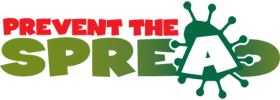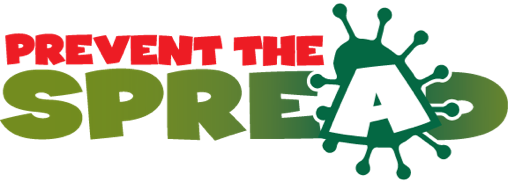
How can we stop germs in their tracks?
GERMS. They lurk in every classroom. Each year, students miss an estimated 164 MILLION school days due to illness. In this project, students will fight back against these microscopic monsters with this public-service project designed to make your school—and the world—a safer and healthier place. They will collect germs from common surfaces such as desks, laptops, and more. Then they’ll test the effectiveness of disinfectants in fighting germs. Finally, they’ll create a public service announcement for their school!
Imagine if kids could keep themselves and their families healthier by developing smart habits to protect against germs. What a great way to build healthy routines to last a lifetime!
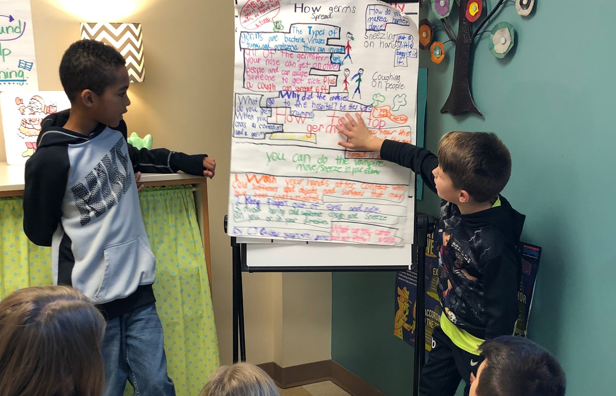
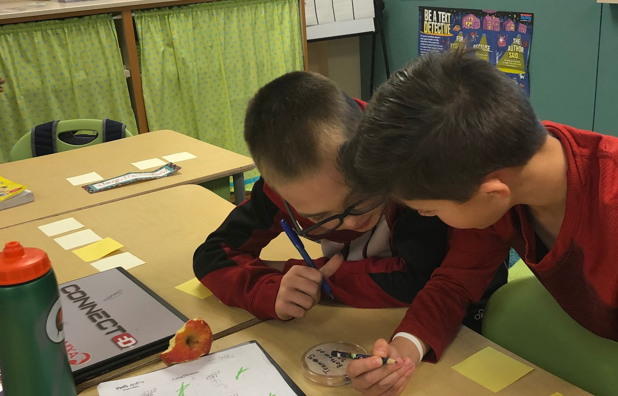
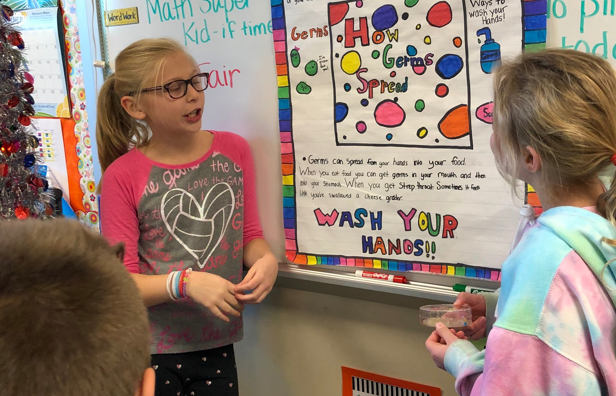
What’s included in your project?
Cross-Curricular Content
Every Blue Apple project provides suggested content correlations to Common Core State Standards, Next Generation Science Standards, and C3 Framework for Social Studies. A featured mini-lesson from each content area is highlighted below along with additional lesson ideas. Not teaching these standards? No problem! Check out the Prevent the Spread K-8 content correlation document for additional lesson ideas.

Math
Multiplying with Arrays
Lesson 2: When you set up your science experiment, you will have six different bacteria sources. Have students use arrays to model and calculate how many petri dishes would be needed to investigate one unsanitized surface and x different sanitizers. They should deduce that you would need 6(x+1) dishes! CCSS.MATH.CONTENT.4.NBT.B.5Real-Life Area
Lesson 4: Students need some way to quantify the growth of the different dishes of bacteria. Teach them to extend their understanding of areas to deal with irregular shapes! CCSS.MATH.CONTENT.4.MD.A.3Understanding Place Value
Lesson 4: Studies estimate that there are 100,000,000 (100 million) individual bacteria in a square inch. Have students study place value by writing the total number of bacteria in each petri dish. CCSS.MATH.CONTENT.4.NBT.A.1Equivalent Fractions
Lesson 4: After approximating the area the germs cover in each petri dish, explain that a dish is approximately 20 square centimeters. Express the fraction of the dish that is covered, and calculate four different equivalent fractions, simplifying as possible. CCSS.MATH.CONTENT.4.NF.A.1

English Language Arts
Key Details
Lesson 1: After reading the article New Handwashing Tool Prevents Germs from Spreading, have students explain what the text states explicitly, as well as what can be inferred from the text. Create a T-chart separating information stated explicitly from information that is inferred. CCSS.ELA-LITERACY.RI.4.1Research
Lesson 3: Have students research germs. Explain that as they record facts that they gather through research, they should also list a source for each fact. Discuss why it is important to record and cite sources. CCSS.ELA-LITERACY.W.4.8Main Ideas and Key Details
Lesson 3: Read Grossology, by Sylvia Branzei, or any other great informational text about germs from the Recommended Book List. Lead students to describe the main ideas of the text, and to identify key details that support these ideas. CCSS.ELA-LITERACY.RI.4.2Planning, Revising, and Editing
Lesson 6: Teach the writing process by discussing prewriting, drafting, editing, revising, and publishing. Have students generate prewriting ideas that they form into a rough draft. Then, students use the Editing and Revising a PSA Checklist to revise, edit, and publish their work! CCSS.ELA-LITERACY.W.4.5
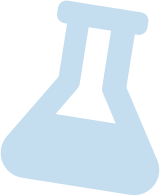
Science
Organism Reproduction
Lesson 2: Explain to students that the visible bacteria on the petri dishes will actually be millions and millions of tiny individual bacteria that have reproduced again and again to form a colony. NGSS 4-LS1-1Science & the Environment
Lesson 3: As you learn about germs, discuss how when we get sick, our bodies make us want to lay down and rest. Our body gets information that it is fighting a disease, and responds by making us want to rest. This response is good, and helps us get better. NGSS 4-LS1-2Multiple Solutions
Lesson 4: Use the investigation into the effectiveness of different sanitizers to launch a discussion on the different ways in which people can be harmed by nature and the ways in which we mitigate these problems. NGSS 3-5-ETS1-2Information Transfer
Lesson 5: As students create their PSAs, discuss the wonders of digital information transfer. Explain how information is encoded into zeros and ones, sent around the world, and decoded for people all over the planet. Information can spread even faster than germs! NGSS 4-PS4-3

Social Studies
Evolving Perspectives Over Time
Lesson 3: As students learn about the history of human understanding of germs, discuss how perspectives changed with increased understanding through the use of the provided video. NCSS D2.HIS.5.3-5Global Impacts
Lesson 3: Discuss how diseases can travel around the world due to human interconnectivity. Have students generate ideas of other problems with potential global impact. NCSS D2.GEO.12.3-5Economic Interdependence
Lesson 5: As students create their PSAs, be attentive to the potential risks and benefits of particular ways to prevent the spread of germs. For example, some germicides may contribute to the evolution of supergerms. NCSS D2.ECO.8.3-5Comparisons with History
Lesson 5: Discuss the historical limitations of PSAs relative to our current abilities to spread useful information. Compare historical and contemporary means of changing society. NCSS D2.HIS.14.3-5

Social Emotional Learning
- Responsible Decision-Making and Social Awareness
Lesson 3: Use a controversial moment in human history to help students explore and discuss how we make responsible decisions that help to make the world a better place. Then, using the video provided, discuss how decisions can be morally right or wrong, and how we use judgement to make that choice.
Not teaching these standards?
No problem! Check out the Prevent the Spread K-8 content correlation document for additional lesson ideas.
Each Blue Apple Project Includes:

- Engaging lessons designed to make learning memorable, meaningful, and fun
- Curated online resources to save you time searching for content
- In-person, virtual, and hybrid options for all learning environments
- Cross-curricular mini-lessons in English-Language Arts, Math, Science, Social Studies, and Social-Emotional Learning
- Videos and contact info provided by real-world experts willing to meet with your students
- Opportunities to collaborate with other classrooms doing the same project
- Free project supplies to get you started right away

